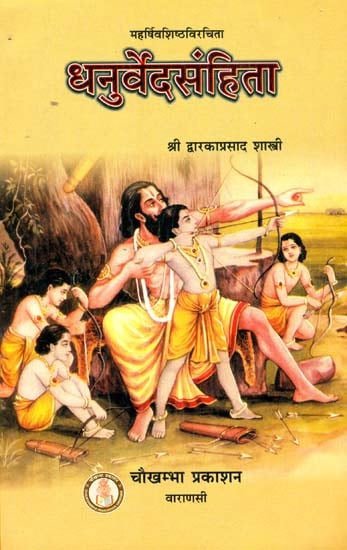Dhanurveda Samhita [sanskrit]
3,015 words
The Sanskrit text of the Dhanurveda-samhita attributed to Vasishtha. Dhanur Veda is a type of ancient India science whose roots date to the 2nd millenium BCE. It is counted among the Upavedas literature. This specific version of the Dhanurveda contains roughly 240 sections of Sanskrit text.
Verse 1.54
पक्ववंशत्वचः कार्य्यो गुणस्तु स्थावरो दृढ ।
पट्टसूत्रेण सन्नद्धः सर्वकर्म्मसहो युधि ॥ ५४ ॥
pakvavaṃśatvacaḥ kāryyo guṇastu sthāvaro dṛḍha |
paṭṭasūtreṇa sannaddhaḥ sarvakarmmasaho yudhi || 54 ||
Note! The following is not a translation of the above verse, but merely an arbitrary extract of the English text.
The skin of a ripe descendant is to be worked on, but the quality is stable and firm. Armed with a thread of cloth he was able to perform all kinds of rituals in battle.
English translation by Hardayalu Swami (2001) Buy now!
Glossary of Sanskrit terms
Note: This extracts Sanskrit terms and links to English definitions from the glossary, based on an experimental segmentation of verse (1.54). Some terms could be superfluous while some might not be mentioned. Click on the word to show English definitions.
Pakva, Vamsha, Tvac, Guna, Sthavara, Dridha, Pattasutra, Sannaddha, Yudh,
Analysis of Sanskrit grammar
Note: this is an experimental feature and only shows the first possible analysis of the Sanskrit text (Verse 1.54). If the system was successful in segmenting the sentence, you will see of which words it is made up of, generally consisting of Nouns, Pronouns, Verbs, Participles and Indeclinables. Click on the link to show all possible derivations of the word.
- Line 1: “pakvavaṃśatvacaḥ kāryyo guṇastu sthāvaro dṛḍha ”
- pakva -
-
pakva (noun, masculine)[compound], [vocative single]pakva (noun, neuter)[compound], [vocative single]√pac -> pakva (participle, masculine)[vocative single from √pac class 1 verb], [vocative single from √pac class 4 verb]√pac -> pakva (participle, neuter)[vocative single from √pac class 1 verb], [vocative single from √pac class 4 verb]
- vaṃśa -
-
vaṃśa (noun, masculine)[compound], [vocative single]
- tvacaḥ -
-
tvac (noun, feminine)[nominative plural], [vocative plural], [accusative plural], [ablative single], [genitive single]
- kāryyo -
-
- guṇas -
-
guṇa (noun, masculine)[nominative single]
- tu -
-
tu (indeclinable particle)[indeclinable particle]
- sthāvaro* -
-
sthāvara (noun, masculine)[nominative single]
- dṛḍha -
-
dṛḍha (noun, masculine)[compound], [vocative single]dṛḍha (noun, neuter)[compound], [vocative single]
- Line 2: “paṭṭasūtreṇa sannaddhaḥ sarvakarmmasaho yudhi ”
- paṭṭasūtreṇa -
-
paṭṭasūtra (noun, neuter)[instrumental single]
- sannaddhaḥ -
-
sannaddha (noun, masculine)[nominative single]
- Cannot analyse sarvakarmmasaho*yu
- yudhi -
-
yudh (noun, feminine)[locative single]yudh (noun, masculine)[locative single]
Other editions:
Also see the following editions of the Sanskrit text or (alternative) English translations of the Verse 1.54
Dhanurveda Samhita (धनुर्वेदसंहिता)
by Hardayalu Swami (2001)
Publisher: Khemraj Shrikrishnadass
Buy now!
Vasistha’s Dhanurveda Samhita
by Purnima Ray (2023)
Publisher: Khemraj Shrikrishnadas; ISBN-10: 818670289X; ISBN-13: 9788186702895; 88 pages including 18 illustrations;
Buy now!
Dhanurveda Samhita (धनुर्वेदसंहिता) (संस्कृत एवं हिंदी अनुवाद)
by Shri Dwarka Prasad Shastri (2007)
Title: Dhanurveda Sanhita (Hindi translation); Publisher: Chaukhambha Prakashan, Varanasi; 84 pages including 11 illustrations; Author: महर्षि वशिष्ठ (Maharshi Vashistha); Foreword by Dr. Chakradhar Bijalwan.
Buy now!![Dhanurveda Samhita [sanskrit] - book cover](/uploads/a/Dhanurveda-Sanskrit.jpg)

